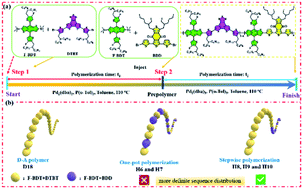Optimizing sequence structures by stepwise-feeding terpolymerization for high-performance organic solar cells†
Abstract
Terpolymerization is a feasible approach to optimize the device performance of organic semiconductors. Yet, since most reported terpolymers utilize a one-pot polymerization method, the regularity of the polymer backbone is severely disrupted, and the sequence structure is roughly unclear. Herein, a novel stepwise-feeding terpolymerization approach is developed to finely adjust the terpolymerization process by utilizing the merits of stereoregular donor–acceptor alternative polymerization as well as irregular random copolymerization. In the novel stepwise-feeding terpolymerization, a pre-polymer of the host polymer D18 was synthesized initially, followed by adding a third unit BDD into the polymer backbone. The obtained H9 terpolymer has a more regular main chain with a more definite sequence distribution than its analogs (H6) prepared by one-pot polymerization. As a result, the stepwise-feeding-based terpolymer H9 offered significantly reduced energy loss in the combination with the Y6 acceptor in blend, yielding a record power conversion efficiency (PCE) of up to 18.50% in the terpolymer-based organic solar cells (OSCs). The results demonstrate that stepwise terpolymerization is an effective approach to developing regular terpolymeric semiconductors for high-performance OSCs.



 Please wait while we load your content...
Please wait while we load your content...